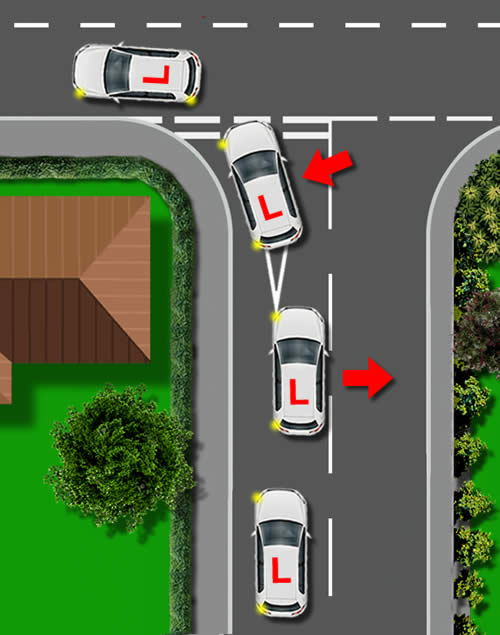During the practical driving test, the driving test routes will cover many T-junctions from marked, unmarked and traffic lights controlled junctions. Examiners will assess your ability to deal with junctions safely, and part of this process involves road positioning.
In order to position yourself properly at T-junctions, it’s important that you follow the MSPSL routine. The number one reason for the top 10 driving test failures every year (official DVSA statistics) is at junctions. This is often due to inappropriate speed and observations. Let’s take a look at the correct road position at T-junctions.
Road Positioning for Turning Left at a T-junction
In this diagram, we have the learner driver turning left at a T-junction, from minor road into major road.

When positioning your car for turning left at a T-junction:
- If you need to stop, avoid stopping over the give way road markings. If you stop over the junction lines and into the road you intend on joining, it may be hazardous to other traffic.
- Keep to the left side of the road and follow the kerbline round. There are 2 reasons for this:
- If the road is wide enough, it’ll allow a vehicle to wait alongside you for turning right (3).
- It’ll allow for better road position when entering the major road.
Incorrect Road Position for Making A left Turn at a T-junction

If you position your car incorrectly when making a left turn at a T-junction, due to the turning radius of your car, you may end up crossing onto the other side of the road before getting back into your correct lane.
Positioning Yourself at Narrow Junctions

On the approach to T-junctions with narrow lanes, you may find that positioning your vehicle to the right side of your lane just prior to following the kerbline round to the left will enable you with a better position for making a left turn. This can improve the angle of your car so that when exiting the junction, you’ll more likely to remain in your lane. Before moving over to the right, always observe your mirrors and always keep within your own lane.
Road Positioning for Turning Right at a T-junction

When positioning your car for turning right at a T-junction:
- When stopping at the T-junction, ensure that the front of your car does not overhang the give way road markings. If you stop over the junction lines and into the road you intend on joining, it may be hazardous to other traffic.
- Keep to the left side of the centre road line. If the road is wide enough, it’ll allow a vehicle to wait alongside you for turning left (3).
Road Positioning at Unmarked Junctions
Unmarked junctions have no road markings and as a inexperienced learner driver, it can be difficult to know where the correct road positioning is at T-junctions.

When stopping at an unmarked T-junction, you’ll need to predict where you think the junction lines would be, if they were there. To do this, on the approach to the T-junction, draw an imaginary line down the centre of the road (use this for turning right) and for the give way lines, observe the furthest kerb stones and draw an imaginary line across the road (1) and use this for stopping your car. This gets easier with practice.
Reference Points for Knowing Where to Stop
As a learner driver, it can be difficult knowing where your car is in relation to the road. For this, we often use reference points. If you need help with road positioning at T-junctions, see reference points for stopping at T-junctions.